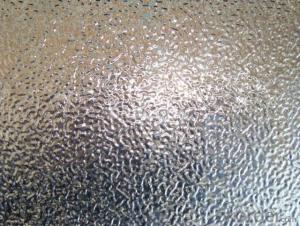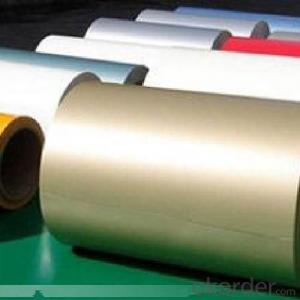Aluminum Sheets Bradenton Fl - Stucco Embossed and Color Coated Aluminum Coils
- Loading Port:
- Shanghai
- Payment Terms:
- TT OR LC
- Min Order Qty:
- 5 m.t.
- Supply Capability:
- 100000 m.t./month
OKorder Service Pledge
OKorder Financial Service
You Might Also Like
1.Structure of Stucco Embossed and Color Coated Aluminum coils
We professionally produce stucco embossed and color coated aluminium coils, which are widely used in ice-boxes, Refrigeratory, cold storage, freezer, central air-conditioners, shells of mechanical equipments, decorations, etc.
Specification of our stucco embossed and color coated aluminium coils: thickness 0.2-0.6mm, width less than 1600mm. As for coating, we normally use PVDF coating, PE coating, etc. We can adjust coating as per customers’ requirements.
Embossed aluminum sheets have many advantages. Embossing can not only increase thickness of aluminum, but also enhance strength and rigidity of aluminum coils. Embossed & coated aluminum coils look more beautiful and widely used in decorations.
2. Main Features of Stucco Embossed and Color Coated Aluminum coils
• Light Weight
• Good in strength and rigidity
• High Flatness
• Good Weathering
• Colorful
• Recycling
• Saving Energy
• Rust proof
3. Stucco Embossed and Color Coated Aluminum coils Images



4. Specification of Stucco Embossed and Color Coated Aluminum coils
ALLOY | TEMPER | THICKNESS | WIDTH | COATING and COLOR |
3003, 3105, etc | H44, etc | 0.2-0.6mm | Less than1600mm | AS PER YOUR REQUIREMENTS |
5. FAQ
A.What about inspections to guarantee quality?
For each order, we will arrange strict inspection for raw materials, inspection during production and inspection for finished goods.
With requirement of customers, we also can arrange the third party inspection.
B.What about delivery?
We will put order in production schedule after order gets confirmed against copy of TT or L/C. Normally it takes about one month for production. Exact shipment schedule is different based on different sizes and quantity.
C.What is the MOQ?
5 tons for each size.
D. Where have you exported?
We have exported to many countries. Main markets include South East Asia, Middle East, North America, South America, etc.
- Q: Are the aluminum sheets suitable for manufacturing automotive fuel tanks?
- Yes, aluminum sheets are suitable for manufacturing automotive fuel tanks. Aluminum is a lightweight and corrosion-resistant material, making it an ideal choice for fuel tank manufacturing.
- Q: Can aluminum sheets be used for insulation cladding?
- Yes, aluminum sheets can be used for insulation cladding. Aluminum is a lightweight and durable material that has excellent thermal conductivity properties. It can effectively reflect heat and prevent the transfer of thermal energy, making it an ideal choice for insulation cladding. Additionally, aluminum sheets are resistant to corrosion, moisture, and fire, further enhancing their suitability for insulation applications. Overall, using aluminum sheets for insulation cladding can help improve energy efficiency, reduce heat loss, and enhance the overall performance of a building or structure.
- Q: What are the different edge treatments available for aluminum sheets?
- There are several different edge treatments available for aluminum sheets, each serving a specific purpose or aesthetic preference. Some common edge treatments for aluminum sheets include: 1. Mill Finish: This is the standard edge treatment for aluminum sheets, where the raw edges of the sheet are left untreated after the manufacturing process. It has a smooth, unfinished appearance. 2. Trimmed: In this treatment, the rough edges of the aluminum sheet are trimmed and smoothed to create a clean, rounded edge. This is often done using shearing or milling techniques. 3. Deburred: Deburring is a process where the sharp edges of the aluminum sheet are removed, typically by filing or sanding, to eliminate any potential hazards or sharpness. It results in a smoother, safer edge. 4. Rolled: Rolled edges are created by bending the edges of the aluminum sheet inward or outward. This treatment provides additional strength and rigidity to the sheet and can also enhance its appearance. 5. Anodized: Anodizing is a surface treatment that involves immersing the aluminum sheet in an electrolytic solution and applying an electric current. This creates a protective oxide layer on the surface, which can be colored to provide an attractive and durable edge finish. 6. Powder Coated: Powder coating involves applying a dry powder paint onto the aluminum sheet, which is then heated to form a hard, protective finish. This treatment can be used to create a variety of colors and textures for the edge. 7. Brushed: Brushed finishes are achieved by brushing the aluminum sheet with abrasive materials, creating a textured and visually appealing edge. This treatment is often used for decorative purposes. 8. Polished: Polishing involves buffing the aluminum sheet to create a smooth, reflective surface. This treatment is commonly used for architectural and decorative applications to enhance the appearance of the edge. These are just a few examples of the various edge treatments available for aluminum sheets. The choice of treatment depends on factors such as the intended use, desired aesthetics, and functional requirements of the aluminum sheet.
- Q: Does anyone know anything about the value of aluminum can(beer, soda, etc.) pull tabs? I have heard a rumor that the tabs are worth more than the cans and that a gallon jug of tabs can be sold at recycling centers for several hundred dollars.Anyone know if this is really true?
- Sept 2014 Update. Aluminum recycle rates continue to be low in comparison to other metals, about 85 cents per pound. 2,000 tabs are worth about $1. A gallon (approximately 4,000 tabs) is worth about $2. The effort needed to collect that many tabs isn't well rewarded. There is no special value for the pull tab - it is simply aluminum. The entire can has more than 100 times the aluminum as the tab itself. While it takes less room, recycling just the tab and throwing away the can doesn't make any sense and isn't worth the time or effort. While they are accepted at charities like the Ronald McDonald House, you are likely to spend more on gas driving them there and would pay approximately twenty times their value in postage if you mail them. Some craft projects use tabs, if you find someone or a group who does this they may give you more than the metal value. Purses made out of pull tabs are somewhat popular. My suggestion - if you recycle - great! Recycle the whole can and realize that you are not going to get yourself or a charity rich because aluminum isn't worth a lot. You are helping the environment though. Take the entire can and any other metal you want to recycle to a local recycler and donate the proceeds however you wish.
- Q: Are 101 aluminum sheets suitable for chemical transfer piping?
- Chemical transfer piping cannot rely on 101 aluminum sheets as they are unsuitable. The reactivity and corrosion propensity of aluminum make it generally unfit for handling specific chemicals. Industries like aerospace or construction prefer aluminum due to its lightweight nature and excellent thermal conductivity. However, for chemical transfer piping, it is wiser to opt for materials that possess corrosion resistance and can endure the specific chemicals being transported. Stainless steel, PVC, or high-density polyethylene (HDPE) are recommended alternatives.
- Q: Can aluminum sheets be used for boat hulls?
- Aluminum sheets are indeed suitable for boat hulls. The lightweight property, high strength-to-weight ratio, and exceptional corrosion resistance of aluminum make it a popular choice for constructing boat hulls. Boat builders often utilize aluminum sheets to craft durable and robust hulls that can withstand the challenges of harsh marine environments. The versatility of aluminum enables the application of various fabrication techniques, making it suitable for a wide range of boat types, such as recreational, fishing, and commercial vessels. Additionally, aluminum hulls necessitate less maintenance compared to alternative materials, offering boat owners a cost-effective solution.
- Q: What is the minimum bending radius for aluminum sheets?
- The minimum bending radius for aluminum sheets depends on the thickness and grade of the aluminum. However, as a general guideline, it is recommended to have a minimum bending radius of 1.5 times the thickness of the aluminum sheet.
- Q: Can aluminum sheets be used for wall cladding?
- Yes, aluminum sheets can be used for wall cladding. Aluminum is a popular choice for cladding due to its lightweight nature, durability, and corrosion resistance. It can be easily shaped and installed, making it a versatile option for various architectural applications, including wall cladding.
- Q: how to distinguish the physical property of copper sheet from the one of aluminum sheet?
- physical property: copper sheet: golden, heavy, aluminum sheet: white, light.
- Q: This question asks for methods to protect aluminum sheets from rusting when exposed to outdoor conditions.
- <p>To prevent rusting of aluminum sheets in outdoor environments, it's crucial to understand that aluminum doesn't rust but forms a thin layer of aluminum oxide, which can darken the surface. To protect aluminum sheets, use protective coatings such as clear anodizing, which enhances the natural oxide layer, or apply a paint or powder coating. Regular cleaning and maintenance can also help in removing dirt and grime that can accelerate the oxidation process. Additionally, using stainless steel fasteners and avoiding contact with dissimilar metals can help prevent galvanic corrosion.</p>
Send your message to us
Aluminum Sheets Bradenton Fl - Stucco Embossed and Color Coated Aluminum Coils
- Loading Port:
- Shanghai
- Payment Terms:
- TT OR LC
- Min Order Qty:
- 5 m.t.
- Supply Capability:
- 100000 m.t./month
OKorder Service Pledge
OKorder Financial Service
Similar products
Hot products
Hot Searches
Related keywords




























